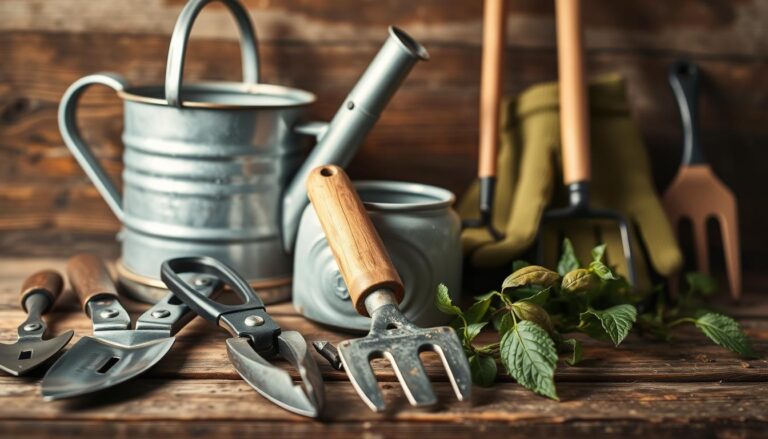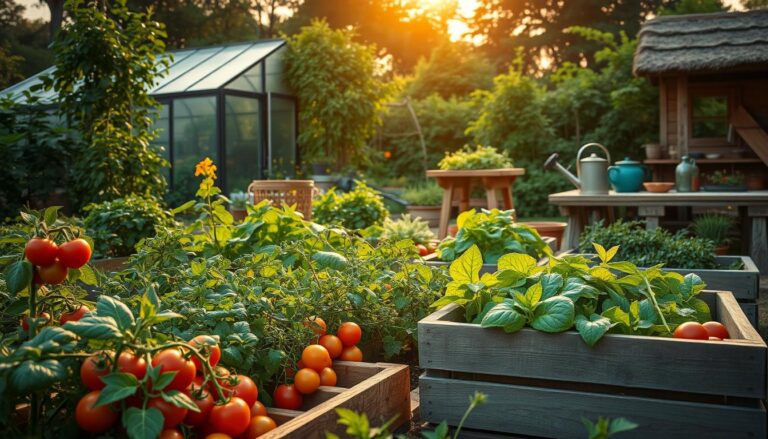Gardening fans are always searching for vegetable garden tips to grow more. One great way is to pair plants to help them grow better.
Choosing the right companion plants can make your garden a healthy place. It helps plants grow well and keeps pests and diseases away.
This method also makes the soil better. It increases yields without using harmful chemicals. It’s a green way to garden.
Learn how to use companion planting in your garden. It will help you get more from your harvest.
The Science Behind Companion Planting
Companion planting is an organic gardening method that uses how plants interact. It helps gardeners make their gardens more balanced and productive.
Understanding Plant Relationships
Plants are not alone; they are part of a complex web of relationships. Mutualism, where both plants benefit, is key in companion planting. For example, the “Three Sisters” method shows mutualism, with corn, beans, and squash together.
Chemical and Physical Interactions Between Plants
Plants talk to each other through chemical signals and physical means. Some plants release chemicals that keep pests away or attract good insects. This makes the garden healthier.
Historical Use of Companion Planting
Companion planting has been around for a long time, used by farmers and gardeners globally. Many indigenous cultures have used it, showing its effectiveness and sustainability. Knowing its history helps us value the knowledge behind plant symbiosis techniques.
By using companion planting, gardeners can create a stronger and more productive garden. They use the natural symbiosis between different plants.
Benefits of Companion Planting for Increased Yields
Companion planting is a top gardening productivity hack. It pairs plants to boost their benefits. By picking the right beneficial plant pairings, gardeners can make their gardens more balanced and productive.
Pest Management Without Chemicals
Companion planting fights pests without chemicals. Plants like marigolds and nasturtiums keep pests away from veggies. For example, marigolds with tomatoes can keep nematodes off, helping veggies grow better.
Maximizing Garden Space Efficiency
Choosing beneficial plant pairings saves space. Sunflowers with lettuce or spinach use vertical space well. They also cut down on shading.
Soil Health Improvement
Some plants, like legumes, fix nitrogen in the soil. This makes the soil healthier. It means less need for synthetic fertilizers, leading to better soil and more crops.
Pollinator Attraction
Companion planting draws in bees and butterflies. These are key for many crops to reproduce. Adding flowers like sunflowers or zinnias can really help yields.
Using these methods, gardeners can have a more productive and strong garden. They get the most out of companion planting and boost their gardening productivity hacks.
Planning Your Companion Planting Garden
To make a companion planting garden thrive, you need a good plan. You must know your garden’s layout, the size of the plants, and what they need to grow.
Assessing Your Garden Space
First, check your garden’s conditions. Look at sunlight, soil, and drainage. Notice any wet or dry spots. This helps pick the best plants for each area.
Creating a Companion Planting Map
Draw a map of your garden. Mark where plants are and where you’ll add new ones. Use garden planning software or apps to help.
Timing Considerations for Planting
Plants grow at different times. Learn what each plant needs to plant at the right time. Some plants need to start indoors before the last frost.
Starting Small: Beginner Companion Planting Beds
Beginners should start small. Try marigolds with tomatoes or basil with peppers. These pairs are easy to handle and can give a lot of food.
Follow these vegetable garden tips and use intercropping strategies. You’ll create a diverse and strong garden ecosystem.
Essential Tools and Resources for Companion Planting
To successfully implement companion planting in your garden, you’ll need the right tools and resources. Companion planting is not just about pairing plants. It’s about creating a harmonious and productive garden ecosystem.
Garden Planning Software and Apps
Garden planning software and apps can simplify designing and managing your companion planting garden. Tools like Garden Planner and Smart Gardener allow you to create detailed garden maps and track progress.
Record-Keeping Systems
Maintaining a record-keeping system is crucial for understanding what works and what doesn’t. This can be a garden journal or digital note-taking apps.
| Tool Type | Examples | Benefits |
|---|---|---|
| Garden Planning Software | Garden Planner, Smart Gardener | Helps in designing garden layouts and tracking progress |
| Record-Keeping Systems | Garden Journal, Digital Note-taking Apps | Aids in monitoring garden performance |
Classic Companion Plant Pairings That Boost Yields
To get the most from your garden, knowing which plants go well together is key. Companion planting is a method where different plants are grown together. This helps them grow better and healthier. By picking the right pairs, your garden can become more balanced and productive.
The Three Sisters: Corn, Beans, and Squash
The “Three Sisters” method is a famous example of companion planting. It involves growing corn, beans, and squash together. This trio was first used by Native American farmers centuries ago. The corn gives the beans something to climb on, the beans fix nitrogen, and the squash keeps the soil cool and moist.
Tomatoes and Their Companions
Tomatoes are a common garden favorite. Some plants, like basil, can make them taste better and keep pests away. Chives and marigolds also help by fighting off nematodes and other pests.
Herb and Vegetable Combinations
Herbs can be great friends to vegetables. For example, dill near cucumbers keeps aphids away. Radish near cucumbers also keeps cucumber beetles off.
Flower and Vegetable Partnerships
Flowers are important in gardening too. Marigolds, for instance, keep nematodes away and attract good bugs. Nasturtiums and calendulas also help by fighting pests and improving soil.
Adding these classic pairs to your garden makes it more diverse and strong. Other good pairs include:
- Nasturtiums with cabbage to keep aphids away
- Garlic near tomatoes to fight spider mites
- Carrots with sage for better growth and taste
These combinations can increase your harvest and make your garden more balanced.
Intercropping Strategies for Maximum Garden Productivity
Maximizing garden productivity is a key goal for gardeners. Intercropping strategies offer a proven method to achieve this. Intercropping involves growing multiple crops together to enhance their growth, health, and productivity.
By adopting intercropping techniques, gardeners can make the most of their garden space. They can also reduce pests and diseases and improve soil health. There are several approaches to intercropping, each with its unique benefits and applications.
Row Intercropping Techniques
Row intercropping involves planting multiple crops in alternating rows. This method allows for efficient use of space and can help in reducing soil erosion. For example, planting marigolds between rows of tomatoes can help deter nematodes.
Strip Intercropping Methods
Strip intercropping involves growing multiple crops in strips that are wide enough to work between but still close enough for the crops to benefit from each other. This technique is particularly useful for large gardens and can help in improving soil health.
Mixed Intercropping Approaches
Mixed intercropping involves growing different crops together in the same bed without a specific pattern. This approach can create a diverse and resilient garden ecosystem. It promotes biodiversity and reduces pest pressure.
Relay Intercropping Timing
Relay intercropping involves planting a second crop into a standing crop before it is harvested. This technique can extend the growing season and increase overall productivity. For instance, planting lettuce between rows of corn can make use of the space before the corn is harvested.
By implementing these intercropping strategies, gardeners can significantly enhance their garden’s productivity. They can create a more sustainable and diverse gardening environment.
Companion Planting for Pest Control
Choosing the right plants for your garden can help keep pests away. This is a key part of organic gardening methods. It uses plant symbiosis techniques to fight pests without harmful chemicals.
Trap Cropping Methods
Trap cropping means planting a crop that pests prefer over your main crops. For example, nasturtiums can draw aphids away from your veggies.
Repellent Plants for Common Garden Pests
Some plants keep pests from damaging your garden. Basil, for instance, keeps aphids and mites away. Marigolds can stop nematodes. Adding these plants can lower pest problems.
Attracting Beneficial Insects
Bringing in beneficial insects is key to pest control. These insects eat pests, keeping your garden balanced.
Predatory Insects That Help Your Garden
Ladybugs and lacewings eat aphids and other pests. Making your garden welcoming to these insects can help control pests.
Plants That Attract Beneficial Insects
Plants like dill, fennel, and cosmos attract helpful insects. Adding these to your garden can bring more beneficial creatures.
Here’s a quick look at some effective ways to use companion planting for pest control:
| Companion Plant | Pest Controlled | Benefit |
|---|---|---|
| Nasturtium | Aphids | Attracts aphids away from crops |
| Basil | Aphids, Mites | Repels pests |
| Marigold | Nematodes | Repels nematodes |
| Dill, Fennel, Cosmos | Various | Attracts beneficial insects |
Integrating Companion Planting with Crop Rotation Benefits
Crop rotation and companion planting are key gardening practices. They work together to boost yields and soil health. By planning garden cycles for years, gardeners create a strong and diverse garden ecosystem.
Planning Multi-Year Garden Cycles
To mix companion planting with crop rotation, start by planning garden cycles for years. Map out which crops will go in each bed over time. This considers the needs and benefits of different plants. A well-planned rotation can help fight soil-borne diseases and pests, making soil healthier.
Plant Family Groupings for Rotation
Grouping plants by family is key in crop rotation. Plants in the same family need similar nutrients and face the same pests and diseases. For example, rotating between Brassicaceae (broccoli, kale) and
Soil Nutrient Management Through Rotation
Crop rotation is also crucial for managing soil nutrients. Legumes, for example, add nitrogen to the soil, helping other crops like leafy greens. By rotating crops with different needs, gardeners keep soil fertile without needing lots of fertilizers. As a gardening expert says, “Crop rotation is a basic practice that lets the soil naturally replenish its nutrients.”
By combining companion planting with smart crop rotation, gardeners boost biodiversity. They also reduce pests and diseases and improve soil health. This leads to a more productive and sustainable garden.
Common Companion Planting Mistakes to Avoid
To get the most out of companion planting, it’s important to steer clear of common mistakes. Knowing these pitfalls helps your garden grow well and your hard work pay off.
Incompatible Plant Combinations
Some plants don’t get along when planted together. For example, broccoli and cauliflower near tomatoes can lower tomato yields. It’s crucial to find plants that go well together for a balanced garden.
Overcrowding Issues
Too many plants in one spot can cause problems. They compete for light, water, and nutrients. This can stunt growth or make plants more prone to disease. Make sure to leave enough space for each plant to grow.
Ignoring Plant Height and Sunlight Needs
Not thinking about how big plants will get and how much sun they need can cause issues. Taller plants can block sunlight from smaller ones, hurting their growth.
Forgetting About Water Requirements
Planting plants with different water needs can be tricky. For example, plants that need a lot of water and those that don’t can be hard to care for together.
By knowing these common mistakes and avoiding them, gardeners can greatly improve their gardening. This leads to a more fruitful harvest.
Measuring Success: Tracking Your Garden’s Performance
To get the most from your garden, tracking its progress is key. This means following a few important steps. These steps help you see how well your garden is doing.
Keeping a Garden Journal
Keeping a garden journal is a must. It’s where you write down when you planted, the weather, and how your garden is doing. This helps you spot trends and make better choices for next year.
Comparing Yields Year-Over-Year
Looking at how much you harvest each year shows how well your garden is doing. This lets you see which plants work best together.
Adjusting Your Strategy Based on Results
After seeing how your garden does, you can tweak your plan. You might try new pairings or change how your garden is laid out.
- Regularly update your garden journal to reflect changes and observations.
- Use yield comparisons to refine your companion planting strategy.
- Be prepared to adjust your approach as needed based on the results.
Conclusion: Growing a Thriving Garden Through Plant Partnerships
By using companion planting, gardeners can make their gardens better. This method helps plants work together, creating a healthy and diverse garden. It also makes the most of the space available.
Companion planting offers many advantages. It helps control pests, improves soil, attracts pollinators, and boosts crop yields. By using these techniques, gardens become more self-sufficient and can handle challenges better.
Whether you’re new to gardening or have been doing it for years, companion planting is worth trying. Try different plant pairs and see how they improve your garden’s health and output.
FAQ
What is companion planting, and how can it benefit my garden?
How do I plan a companion planting garden?
What are some classic companion planting combinations that work well together?
How can companion planting help with pest control?
Can I use companion planting with crop rotation?
What are some common mistakes to avoid when using companion planting?
How can I measure the success of companion planting in my garden?
Are there any digital tools or resources that can help me with companion planting?

Sortemdia nasceu com o propósito de trazer alegria e oportunidades para todos por meio de sorteios gratuitos de prêmios incríveis. O site tem como missão oferecer experiências acessíveis, divertidas e justas para quem deseja concorrer a produtos, serviços e brindes sem pagar nada por isso. Acreditamos que a sorte pode bater à porta de qualquer pessoa — e no Sortemdia, ela pode chegar com apenas um clique.



